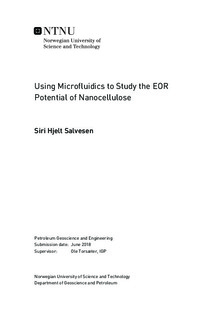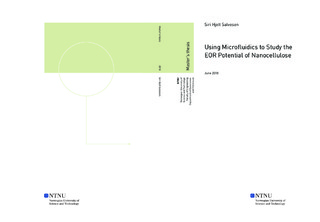| dc.description.abstract | As many of the existing oil reservoirs show declining production, there is a need for research on enhanced oil recovery (EOR) techniques that can accelerate further production. The use of nanoparticles to enhance oil recovery is a promising trend that is believed to introduce a green alternative EOR technique. An apparatus and method that can be used to study the flow of these nanofluids through a porous medium is microfluidics. Microfluidics is a method that enables visualization of fluid flow at the micrometer scale.
This master thesis aims to study the possibilities of using nanocellulose to enhance oilrecovery. A microfluidics apparatus was used as a tool to study the oil saturation during secondary and tertiary flooding of two types of nanocellulose: CNC and TEMPO-CNF. 1% CNC and 0.1% TEMPO-CNF in a low salinity water solution (0.1 wt% NaCl) were used for all experiments. CNC was additionally heated to 120 C and injected tertiary in the microfluidics apparatus. Some important properties of the fluids were measured to support the results obtained from the microfluidics flooding. An optimization study of the experimental setup was performed continuously during this master thesis, and some of the experiments were performed on both the old and the improved setup.
No significant decrease in oil saturation was observed during microfluidics flooding with the two nanofluids, except for secondary flooding with TEMPO-CNF. However, some of the measurements of the nanofluid properties showed promising results. Microfludicis is a relatively new method, and the possibilities of using microfluidics to study the oil saturation is not yet fully established. The validity of the microfluidics experiments is unclear as there were a lot of uncertainties related to the apparatus. Microfluidics might work better as a tool to visualize the flow rather than focusing primarily on flooding and oil saturation. | |

